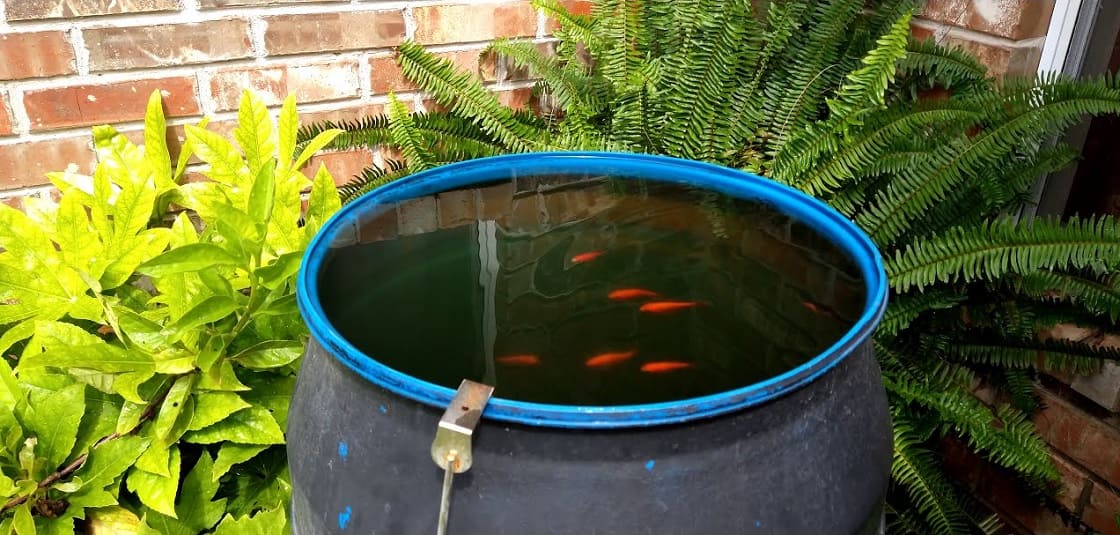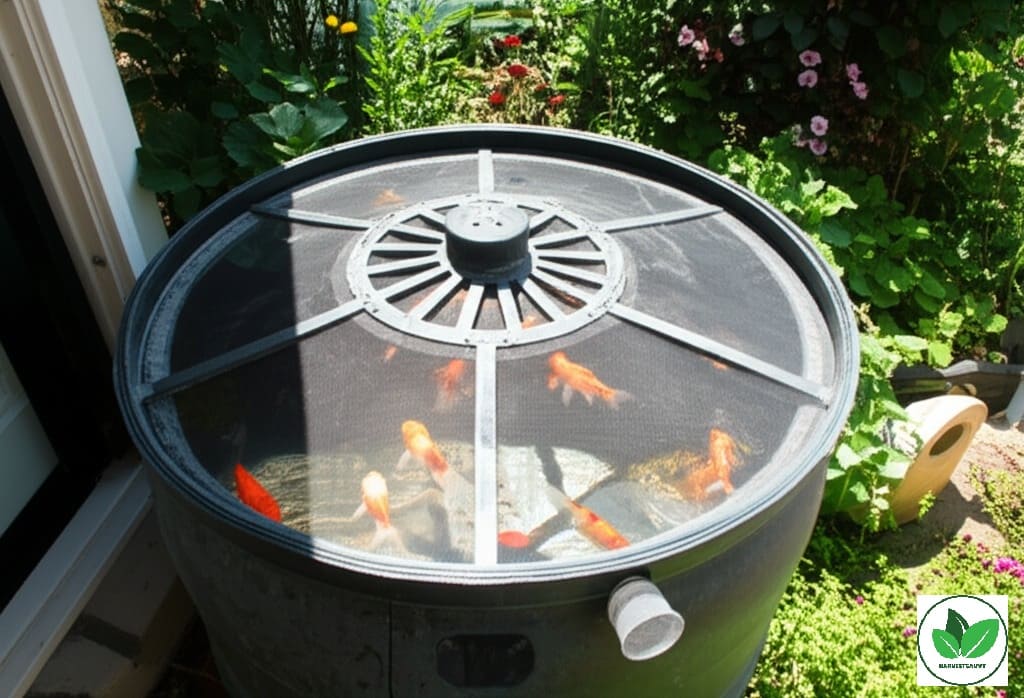Rain barrels have become increasingly popular among eco-conscious gardeners for good reason. They collect valuable rainwater from roofs, reducing water bills and providing plants with chemical-free irrigation. However, standing water inevitably attracts mosquitoes, creating an annoying and potentially dangerous pest problem.
When I installed my first rain barrel five years ago, I was thrilled about conserving water but quickly discovered the mosquito challenge. After researching several options, I stumbled upon a solution that was both elegant and effective: goldfish.
These humble aquatic companions transformed my rain barrel from a mosquito breeding ground into a self-maintaining mini-ecosystem that benefits my entire garden.
In this comprehensive guide, I’ll share everything I’ve learned about maintaining goldfish in rain barrels—combining the best practices from experienced gardeners with solutions to common challenges. Whether you’re a seasoned rain barrel user or just getting started, this natural approach to mosquito control might be exactly what you need.
Benefits of Keeping Goldfish in Rain Barrels
Natural Mosquito Control That Really Works
Mosquitoes can be a persistent problem, especially during summer months. By introducing goldfish to your rain barrel, you utilize a natural method to control mosquito populations.
Goldfish are adept at controlling mosquitoes because they readily consume mosquito larvae, a vital part of the mosquito lifecycle. Without larvae, mosquitoes cannot mature. The fish continuously scavenge the water’s surface, eating these larvae before they transform into adult mosquitoes.
Several gardeners in my community gardening club have reported remarkable results, with mosquito problems virtually eliminated within days of adding fish. The effectiveness is impressive—a rain barrel with healthy goldfish will remain largely mosquito-free with minimal additional intervention needed.
Explore The Best Mosquito Repelling Plants for Your Garden
Water Quality Improvement and Algae Management
Beyond mosquito control, goldfish help maintain cleaner water in your rain barrel. Goldfish continuously scavenge the water, keeping it cleaner and more suitable for garden use. Their presence helps maintain the cleanliness of the water by eating algae and other organic materials, providing biological filtration that significantly improves water quality.
I’ve noticed that my planters thrive when watered with this naturally filtered water. The slight reduction in algae growth means fewer clogs in watering cans and irrigation systems, making the entire watering process more efficient.
Fish Waste: Free Fertilizer for Your Garden
One unexpected benefit I’ve discovered is that goldfish waste serves as an excellent natural fertilizer. The fish poop provides a little extra nitrogen-rich fertilizer for plants. This waste creates a mild, organic fertilizer that’s perfect for garden plants, vegetables, and flowers.
My tomato plants show visibly better growth when watered with the nutrient-enriched barrel water compared to those watered with tap water. The fish waste provides a gentle, continuous source of nutrients without the risk of chemical burn that commercial fertilizers sometimes cause.
Here’s how to Boost Tomato Growth with Fish Heads: A Secret Gardening Hack
A Teaching Tool for Children
Having goldfish in your rain barrel creates wonderful learning opportunities for children. My niece and nephew are fascinated by our “garden fish” and have learned valuable lessons about ecosystems, water conservation, and the life cycles of both fish and mosquitoes.
This living example of natural pest control helps children understand ecological relationships in a tangible way.
Learn How to Create a Fun and Educational Vegetable Garden for Kids
Setting Up Your Rain Barrel Fish Habitat
Choosing the Right Barrel
Setting up a rain barrel for goldfish requires careful planning to ensure the fish thrive. First, choose a suitable rain barrel. Plastic barrels are generally the best material because they are durable and won’t leach harmful chemicals into the water.
I recommend:
- A barrel size of at least 50 gallons (larger if possible)
- Food-grade plastic or specially designed rain barrels
- Dark-colored barrels to reduce algae growth
- A secure lid with appropriate openings for downspouts
- A spigot positioned at least 6-8 inches from the bottom
Ideal Placement for Fish Health
Place the barrel in a shaded area to prevent overheating. Goldfish are hardy but prefer cooler water temperatures. Direct sunlight can cause the water to heat up quickly, which is not ideal for goldfish in a rain barrel.
In my experience, the north or east side of buildings provides ideal partial shade. I’ve positioned my barrel where it receives morning sun but is protected from the intense afternoon heat, keeping water temperatures in the comfortable range for goldfish throughout most of the year.
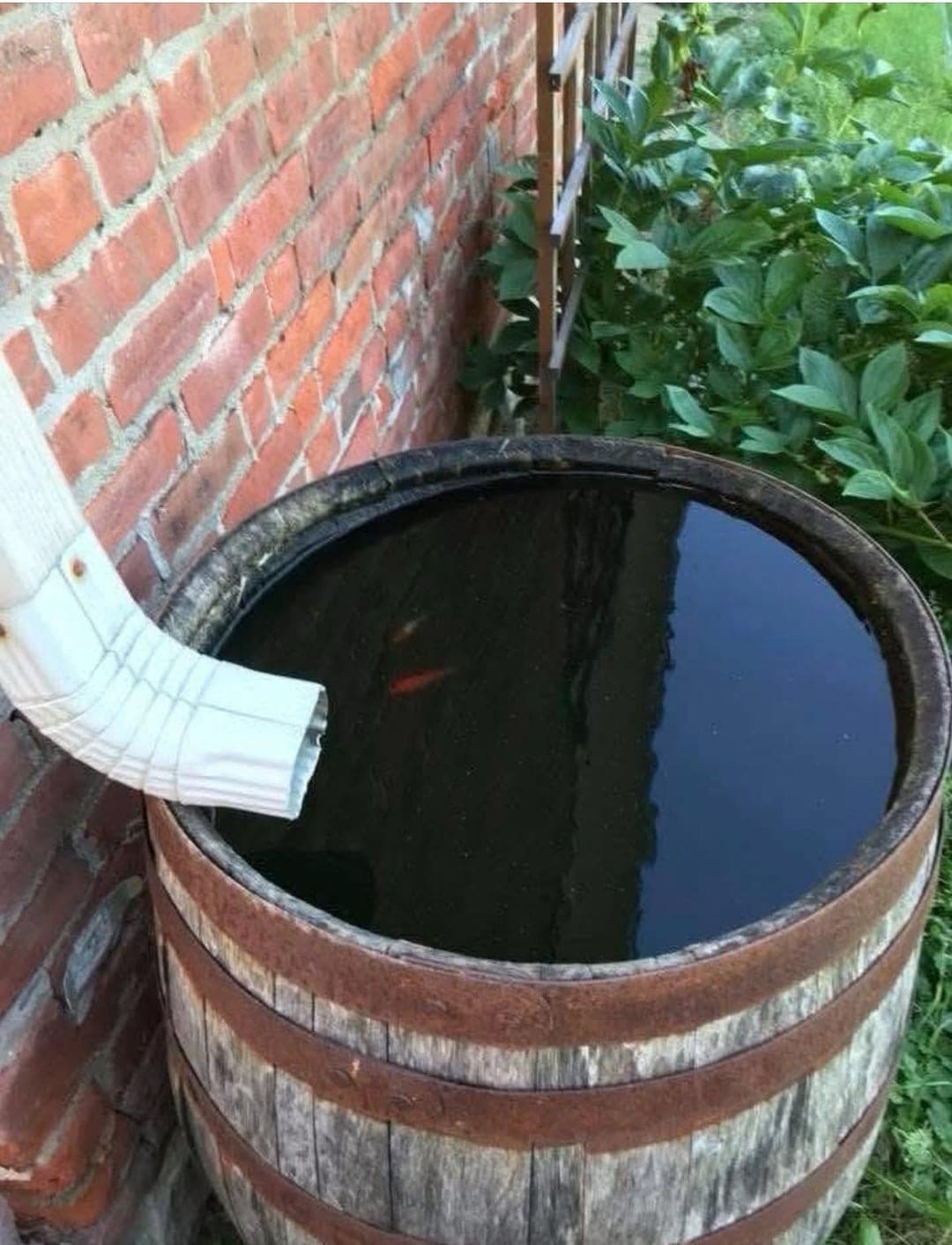
Making Modifications for Fish Success
Several simple modifications can dramatically improve fish survival rates:
Install a mesh or debris filter at the top of the barrel. This prevents large debris from entering the water and provides an added layer of safety for the goldfish. A lid or netting can also help to keep predators away from your goldfish in the rain barrel.
I’ve added a simple overflow tube near the top of my barrel with mesh covering to prevent fish from escaping during heavy rains. This allows excess water to drain without losing your aquatic helpers.
Creating a Complete Mini-Ecosystem with Plants
Introduce aquatic plants like water lilies or anacharis to your rain barrel. These plants help to oxygenate the water and provide hiding spots for the goldfish. They also assist in maintaining water quality by absorbing excess nutrients.
My own setup includes floating water lettuce and submerged anacharis, which create natural shade, oxygen, and shelter for the fish. The plants also compete with algae for nutrients, helping to keep the water clearer. I’ve found this plant-fish combination creates a self-balancing ecosystem that requires minimal intervention.
Learn How to Build a Bee Watering Station With Tips and Ideas for a Bee-Friendly Yard
Selecting the Right Fish
Goldfish vs. Other Options
While common goldfish work wonderfully in rain barrels, several other fish types have proven effective:
The best type of goldfish for a rain barrel is one that is hardy and can thrive in smaller spaces. Common goldfish and comet goldfish are often recommended due to their resilience and adaptability.
These goldfish are part of the Cyprinid family and are known to survive in varied water conditions. Fancy goldfish, on the other hand, may not be the best choice as they often require more stable water parameters and a larger living space.
Other options include:
- Mosquito fish/Gambusia: Native to some regions and specifically evolved to eat mosquito larvae
- Guppies: Colorful, breed easily, and effective at eating larvae
- Minnows: Inexpensive and very hardy in outdoor conditions
- Betta fish: Can survive in low-oxygen conditions but less cold-tolerant
From personal experience, common goldfish have proven most successful in my climate (hardiness zone 6), surviving both summer heat and moderate winter freezes when properly managed.
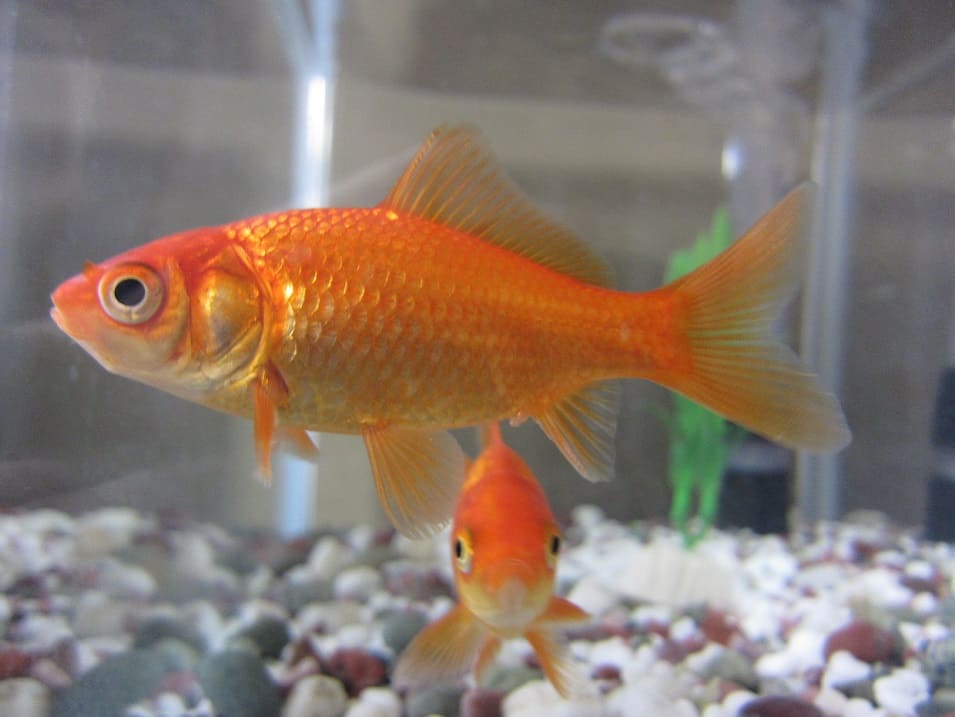
How Many Fish to Add
When selecting goldfish, consider their potential size. Goldfish can grow quite large, with some reaching up to 12 inches. It’s crucial to not overstock your rain barrel. A couple of goldfish are typically sufficient for controlling mosquito larvae and maintaining the ecosystem.
I’ve found that two to three small goldfish in a 55-gallon barrel provide excellent mosquito control without overcrowding. Remember that while they start small, goldfish can grow significantly in favorable conditions.
Where to Get Fish and Cost Considerations
Using rain barrels with goldfish is an economical way to manage small water systems. Goldfish are relatively low maintenance compared to other domesticated fish.
The most cost-effective options are:
- “Feeder goldfish” from pet stores (usually $0.15-$0.50 each)
- Local fish farms or aquarium shops
- Garden centers that specialize in pond supplies
- Online aquarium suppliers (though shipping adds cost)
I purchased my first goldfish from a local pet store for just 29 cents each. Despite their humble origins, they’ve proven remarkably resilient and effective at mosquito control.
Properly Introducing Fish to the Barrel
When adding goldfish to your rain barrel, start with a small number, such as two or three fish. This prevents overcrowding and allows you to monitor the water conditions more easily. Remember that goldfish can grow quite large, so it’s important not to overstock the rain barrel.
To introduce fish safely:
- Fill your barrel and let it sit for 2-3 days to allow chlorine to dissipate
- Float the bag with fish in the barrel water for 15-30 minutes to equalize temperature
- Add some barrel water to the bag every 5 minutes for about 20 minutes
- Gently release the fish into the barrel (try not to add pet store water)
- Monitor closely for the first week and be prepared to add fresh water if needed
Following this acclimation process significantly increased survival rates for my fish, allowing them to adjust gradually to their new environment.
Maintaining Your Rain Barrel Fish Habitat
Feeding Considerations
Fish in rain barrels generally require little to no supplemental feeding. In a well-established barrel, goldfish will feed on mosquito larvae, algae, and insects that fall into the water. Overfeeding can lead to poor water quality and is a common cause of fish death.
During the warm months, I rarely feed my goldfish as they find plenty of natural food. In periods with fewer insects or larvae, I occasionally add a small pinch of fish flakes once or twice a week—just enough that they consume it all within five minutes.
Water Quality Management
Regular maintenance is crucial. Check the water quality weekly and perform partial water changes if necessary. Remove any debris that accumulates, and make sure the aeration system is functioning properly.
To maintain water quality:
- Never use chemicals or algaecides in fish-inhabited barrels
- Keep debris screens clean to prevent rotting material
- Use water regularly to ensure fresh rainwater replaces older water
- Leave at least 1/3 of the water in the barrel when watering plants
- Consider adding beneficial bacteria products designed for ponds
I’ve found that using about 5-10 gallons of water twice weekly keeps my barrel water fresh while providing ample irrigation for my garden.
Related post: Farm Water Planning for Livestock & Land Management
Preventing Overflow and Water Loss
Managing water levels is important for fish health and mosquito control:
- Install an overflow hose that directs excess water to plants or a second barrel
- Use a rain diverter on your downspout during extremely heavy rainfall
- Keep the barrel at least 2/3 full during hot weather to prevent overheating
- Mark a minimum water line to ensure you never drain too much water
During our unexpected drought last summer, I installed a simple rain diverter that allowed me to direct the first rainfall after a dry period directly into the barrel, bypassing our potentially dirty roof and ensuring my fish had sufficient water.
Seasonal Care Guide
Spring Startup
In spring, the temperature begins to rise, and so does the activity level of your goldfish in rain barrel. Ensure your rain barrel is free from debris and check for leaks. Spring is a good time to introduce new plants that can help with oxygenation and hiding spots.
My spring routine includes:
- Cleaning debris screens and checking for winter damage
- Testing water quality as fish become more active
- Adding new aquatic plants if needed
- Beginning regular water use as garden needs increase
- Adding beneficial bacteria to jump-start the biological cycle
Summer Heat Management
Summer heat can cause water temperature in the rain barrel to spike. Ensure your rain barrel is placed in a shaded area to prevent overheating. Goldfish in rain barrel systems can benefit from extra aeration during this hot season. Monitor oxygen levels closely and avoid overfeeding to maintain water quality.
During the hottest days of summer, I’ve found these strategies effective:
- Add extra floating plants to increase surface shade
- Use the water more frequently to introduce cooler rainwater
- Consider adding a small solar aerator if temperatures consistently exceed 85°F
- Check fish behavior daily—fish gasping at the surface indicates oxygen problems
Fall Preparation
Fall brings cooler temperatures, which means the goldfish in rain barrel will become less active. Prepare your rain barrel for falling leaves by using a mesh cover. Remove any decaying plant matter to keep the water clean. Gradually reduce feeding as temperatures drop.
My fall maintenance includes:
- Adding extra leaf protection over barrel openings
- Trimming back excess plant growth
- Performing a 25% water change before winter
- Considering whether to bring fish indoors based on your climate
Winter Survival Strategies
Winter is the most challenging season for goldfish in rain barrel setups. If temperatures plummet, ensure your rain barrel doesn’t freeze completely. Consider adding a heater to keep the water above freezing. Alternatively, move goldfish to an indoor tank if the climate is too harsh.
In my moderate winter climate, I’ve successfully overwintered goldfish in the barrel by:
- Adding a floating de-icer (used for bird baths) during extreme cold spells
- Keeping the barrel full to maximize thermal mass
- Adding insulation around the barrel (straw bales work well)
- Creating a small hole in any ice that forms to allow gas exchange
During one particularly harsh winter, I did bring my fish indoors to a temporary 10-gallon tank, but in most years, they’ve survived outdoors with these modifications.

Troubleshooting Common Issues
Fish Deaths and Possible Causes
If your fish aren’t thriving, consider these common culprits:
- Chlorine exposure: Always let collected water stand for at least 24-48 hours before adding fish to allow chlorine to dissipate. Use a water conditioner if your tap water is heavily chlorinated.
- Temperature extremes: Fish gasping at the surface often indicates water that’s too warm or has insufficient oxygen.
- Poor water quality: Ammonia build-up from fish waste can become toxic. Perform partial water changes and consider adding beneficial bacteria products to help establish the nitrogen cycle.
- Overcrowding: Too many fish in a small barrel depletes oxygen and increases waste.
After losing my first batch of fish, I discovered our roof shingles had been treated with algaecide. Waiting for several good rainfalls to clean the roof before restocking solved the problem.
Predator Protection
Predators can pose a risk to goldfish in rain barrels. Birds, raccoons, and other animals may try to access your rain barrel to catch the fish. Installing a secure, tightly fitting lid or a mesh covering can help protect your goldfish from predators while maintaining good aeration.
I’ve found that covering all openings with strong mesh (hardware cloth works well) prevents both predator access and mosquito entry/exit, providing double protection for your water system.
Water Temperature Extremes
Temperature fluctuations are another challenge. Goldfish are hardy, but extreme temperatures can still stress them. In summer, high temperatures can lead to low oxygen levels, while in winter, freezing temperatures can be lethal.
To mitigate this, situate your rain barrel in a shaded area during the summer and insulate it against extreme cold in the winter. This helps stabilize the water temperature and ensures your goldfish’s well-being.
Monitor your barrel temperature with an inexpensive aquarium thermometer. Ideal temperatures range from 50-75°F (10-24°C), though goldfish can survive brief periods outside this range with proper preparation.
Real Success Stories
The 32-Year-Old Rain Barrel Goldfish
In one remarkable case from Ireland, Detta Connor kept a goldfish named ‘Olivia’ in a rain water barrel outside for 32 years. Detta and her husband Cianan bought the goldfish for their daughter Olivia and granddaughter Donna 32 years ago.
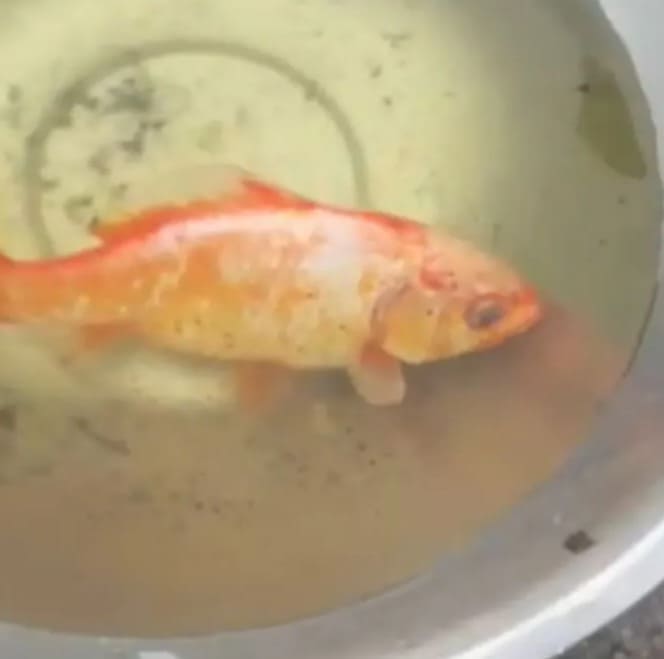
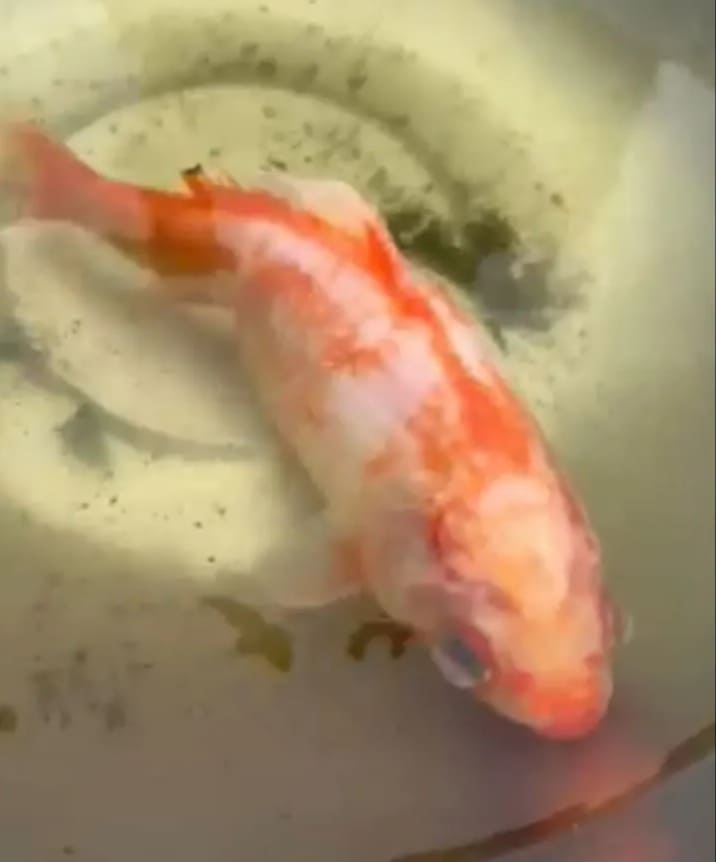
After about ten years in various indoor locations, Cianan decided to put the fish into a rainwater barrel outside. Despite Ireland’s variable climate, Olivia thrived in all weather conditions. They’ve even had to break ice at the top of the barrel after cold nights.
Cianan feeds Olivia with a few flakes of fish food every morning, which is the only time the fish comes to the top of the barrel. They clean out the barrel regularly but try not to clean away the algae at the bottom which the fish eats. Their barrel has holes to prevent overflow and is positioned low enough so birds or cats can’t access the fish.
Community Success Stories
Across various gardening forums and communities, there are countless testimonials of successful rain barrel fish setups:
In one case shared online, a rural resident mentioned, “We have put goldfish in our cow’s water troughs forever. They keep it crystal clear!”
“I’ve had gold fish in my barrel and troughs for years without any problems what so ever. I’ve had them to start out an inch long and grow to be 4-6 inches over years,” shared one experienced gardener.
Another added, “We’ve had a rain barrel/gold fish barrel for 3 years and have never had to feed the fish or worry about the heat (it’s shaded after about 1 pm). In the winter we knock a hole in the ice and that’s all we have ever had to do to ours. They sure do wipe out the larvae.”
These real-world experiences demonstrate the remarkable adaptability of goldfish and their effectiveness in controlling mosquitoes in various water storage systems.
Alternative Mosquito Control Methods for Rain Barrels
If fish aren’t suitable for your situation, consider these alternatives:
Physical Barriers
Fine mesh or netting attached firmly to the barrel keeps mosquitoes out. Attach the netting to the barrel with a bungee cord.
I’ve seen creative uses of window screen material secured with bungee cords or zip ties to create effective mosquito barriers while still allowing rainwater entry.
Surface Treatments
Liquid dish soap creates a slick film on the surface of the water. When mosquitoes attempt to land, they drown before they have time to lay eggs. Use natural soap and avoid products with perfume or degreasers, especially if you water your plants with rainwater. One or two tablespoons of liquid soap per week is plenty for most rain barrels.
Vegetable oil floats on the surface of the water. If mosquitoes attempt to land, they suffocate in the oil. Use about a quarter cup of oil per week. You can use any type of oil, including olive oil. Horticultural oil or dormant oil are also effective for preventing mosquitoes in rain barrels.
Bacterial Options
Mosquito dunks, also known as mosquito donuts, are round cakes of Bti (Bacillus thuringiensis israelensis), a naturally occurring bacteria that provides mosquito control in rain barrels as it slowly dissolves.
However, it is safe for beneficial insects. Be sure the product label indicates the dunks are formulated for ponds because other types, which kill caterpillars, aren’t effective in water. Replace the dunks as needed.
I’ve found that combining methods—such as using both mesh barriers and occasional Bti treatments during peak mosquito season—provides the most comprehensive protection without fish.
Conclusion: A Sustainable Solution for Garden and Environment
Adding goldfish to your rain barrel creates a beautiful synergy between water conservation and natural pest management. These hardy little fish transform a simple water collection system into a living ecosystem that benefits your garden in multiple ways:
- Eliminate mosquito breeding without chemicals
- Improve water quality naturally
- Provide mild organic fertilization for plants
- Create learning opportunities for children
- Add visual interest to your garden
My journey with goldfish in rain barrels began as a simple experiment five years ago and has evolved into one of my favorite garden features. Visitors are always intrigued by the flashes of orange beneath the water surface, and I enjoy explaining how these humble fish contribute to both pest control and plant health.
If you’re struggling with mosquitoes in your rain barrel or simply want to enhance your water conservation system, consider this time-tested solution. With proper setup and minimal maintenance, your goldfish can become valuable garden partners for years to come.
By implementing the strategies outlined in this guide, you’ll not only reduce mosquito populations but also take another step toward a more sustainable, interconnected garden ecosystem that works with nature rather than against it.
FAQ: Goldfish in Rain Barrels
- Q: How many goldfish should I put in my rain barrel?
A: For a standard 55-gallon rain barrel, 2-3 small goldfish is ideal. Too many fish can lead to poor water quality and oxygen depletion.
- Q: Do I need to feed the goldfish in my rain barrel?
A: In most cases, goldfish will find sufficient food from mosquito larvae, algae, and insects that fall into the water. Occasional supplemental feeding (once weekly) during colder months may be beneficial.
- Q: What should I do with the goldfish during winter?
A: In mild climates, goldfish can overwinter in the barrel if it doesn’t freeze solid. In severe climates, bring them indoors to an aquarium for winter. Always ensure there’s a hole in any ice that forms to allow gas exchange.
- Q: How long do goldfish typically live in rain barrels?
A: With proper care, goldfish in rain barrels can live 5-10 years or more. Some exceptional cases have been documented of goldfish living over 30 years in outdoor barrels!
- Q: Why did my goldfish die shortly after being placed in the rain barrel?
A: Common causes include chlorine in the water, temperature shock, poor water quality, or contaminants from the roof or barrel. Ensure the barrel has been rinsed thoroughly and the water has sat for 24-48 hours before adding fish.
